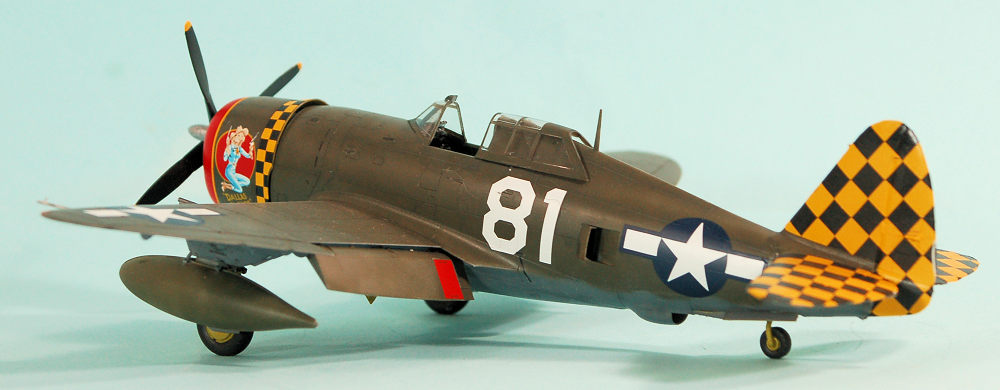
Tamiya 1/48 P-47D Thunderbolt 'Razorback'
| KIT #: | 61066 |
| PRICE: | $25.00 (estate sale) |
| DECALS: | Two Aircraft |
| REVIEWER: | Tom Cleaver |
| NOTES: | Cutting Edge decals 48-127 “Thunderbolt Nose Art Part 2" |

| HISTORY |
Writing in the "Flight Journal," P-47 special issue, famed Grumman test pilot Corky Meyer - the last actual "airplane person" to head a major airplane company - named the P 47 Thunderbolt the "best fighter of World War II - ETO." As he pointed out, it had high performance, yet a wartime trained 200 hour pilot could fly it. It had a well laid out cockpit in which all the controls, switches, and instruments were handily located. It exceeded at three of the four performance parameters he established: air combat capability, fighter escort capability, ground support capability and photo reconnaissance (it only missed on the latter).
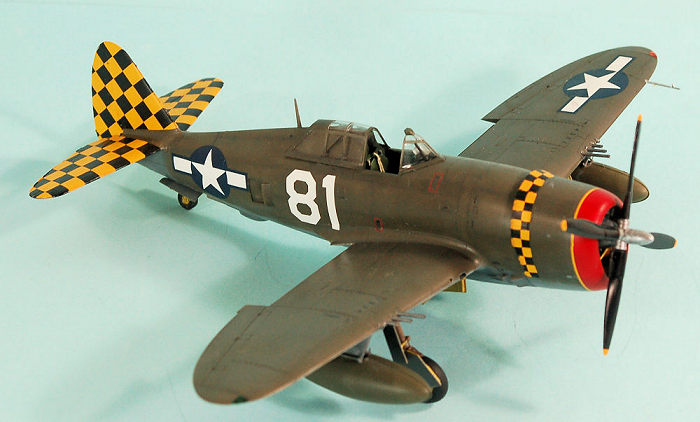 With
15,683 Thunderbolts produced between 1941 45,the P-47 is the most produced
American fighter ever. Republic delivered one in 1941, 532 in 1942, 4,428 in
1943, 7,065 in 1944 and 3,657 in 1945. 730 were operated by the RAF in
Southeast Asia, while 446 flew for the French Air Force in Europe. The only
theater of war in which the Thunderbolt did not fight was the Aleutians. It
is telling that the two top scoring American fighter pilots in the ETO both
flew P 47s exclusively, and all 10 of the top P 47 aces in the ETO survived
the war.
With
15,683 Thunderbolts produced between 1941 45,the P-47 is the most produced
American fighter ever. Republic delivered one in 1941, 532 in 1942, 4,428 in
1943, 7,065 in 1944 and 3,657 in 1945. 730 were operated by the RAF in
Southeast Asia, while 446 flew for the French Air Force in Europe. The only
theater of war in which the Thunderbolt did not fight was the Aleutians. It
is telling that the two top scoring American fighter pilots in the ETO both
flew P 47s exclusively, and all 10 of the top P 47 aces in the ETO survived
the war.
The Checkertail Clan
The 325th Fighter Group, which would become famed during World War II as “The Checkertail Clan” for the yellow-and-black checkers that adorned the tails of their P-40s, P-47s and P-51s, arrived in North Africa in the Spring of 1943, in time to take part in the final battles in Tunisia, then move on to fight over Siciliy. In October 1943, following the invasion of Italy, they turned in their P-40F and P-40L Warhawks for P-47 Thunderbolts. When the new 15th Air Force was formed that November, the group was transferred from the 12th Air Force to the new strategic air force. At the time, they were the only single-engine fighter group in the “Forgotten Fifteenth”, operating alongside the P-38s of the 1st, 14th, and 82nd Fighter Groups.
On December 9, 1943, the Clan left their base in Soliman, Tunisia, and moved to Foggia Main air base in southern Italy, flying their first operational mission on December 14. The italian winter weather was bad, and on Christmas Day three pilots were killed in weather-related accidents. With Foggia Main getting crowded with bomber groups, the Clan moved to Foggia One at Celone, Italy, on December 30. That day, they flew an escort mission to Greece, where their first Thunderbolt victories were notched up: three Bf-109s.
 By
the third week of January, 1944, the Clan had 15 confirmed victories, with
12 scored against Italian and German units around Rome.
By
the third week of January, 1944, the Clan had 15 confirmed victories, with
12 scored against Italian and German units around Rome.
Due to a lack of yellow and black paint, the group’s P-47s did not receive their “checkertails” until late March and early April, 1944.
One of their more memorable missions was an attack on the Luftwaffe airbase at Villaorba in northern Italy, on January 30, 1944. Departing Foggia One the Thunderbolts flew over the Adriatic at 50 feet to avoid radar detection. Climbing to altitude as they headed inland, they hit the airfield shortly after noon and completely surprised the enemy. For 35 minutes, they had a “turkey shoot.” Herschel Green of the 317th Fighter Squadron claimed four Ju-52s, a Do-17 and a Macchi C.202 to become “an ace in a day.” He might have scored more, had he realized that the borrowed P-47 he was flying had the full load of 800 rounds per gun, rather than the 400 rpg normally carried by Checkertail P-47s to lighten them for combat.
The raid was a success, and was followed by 76 B-17s that bombed the airfield. Major Bill Chick scored two Bf-109s that day. Years later, when he was Air Attache in Lima, Peru, he met a German businessman and discovered he had flown Bf-109s during the war. The German told Chick he had been shot down three times - twice by B-17s and once by a P-47 in Italy. The two men compared notes, and realized Chick had shot him down. “We were going at it over the field when he suddenly straightened and accelerated. I looked up and saw the B-17s directly overhead that had just dropped their bombs! I was trying to pass him till we got clear of the field, then turned in behind him and let him have it.” The two became friends in Peru.
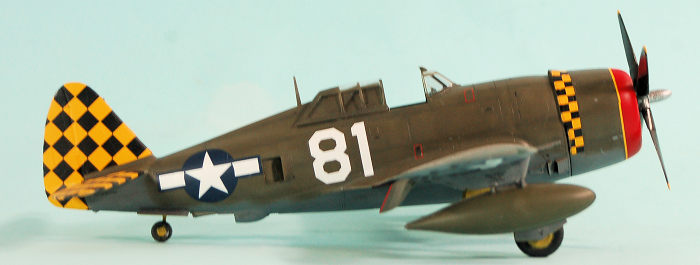 Large-scale
air battles over Italy continued through March and April 1944 as the Allies
fought four different battles to take Monte Cassino and move on to Rome. The
Checkertails claimed over 50 victories during these missions, while also
moving their base 45 miles north to Lesina.
Large-scale
air battles over Italy continued through March and April 1944 as the Allies
fought four different battles to take Monte Cassino and move on to Rome. The
Checkertails claimed over 50 victories during these missions, while also
moving their base 45 miles north to Lesina.
Beginning in April, escort missions extended beyond Italy to Austria, Hungary and Yugloslavia. The group was now fully equipped with later-production P-47s which had underwing shackles that enabled them to carry two 165-gallon P-38 drop tanks giving them a six-hour range.
On May 24, the Clan flew their 97th and last P-47 mission, an escort to Weiner Neustadt, Austria, to attack the Messerschmitt factory complex. Six Bf-109s were shot down, including two credited to 1st Lieutenant Donald P. Kearns, whose “Dallas Blonde” was one of the most colorful P-47s in the group, being the only one with yellow-black checkers on the cowling flaps.
“Herky” Green emerged as the top-scoring ace of the Clan’s P-47 period, adding 10 victories in the Thunderbolt to three scored when he flew Warhawks.
| THE KIT |
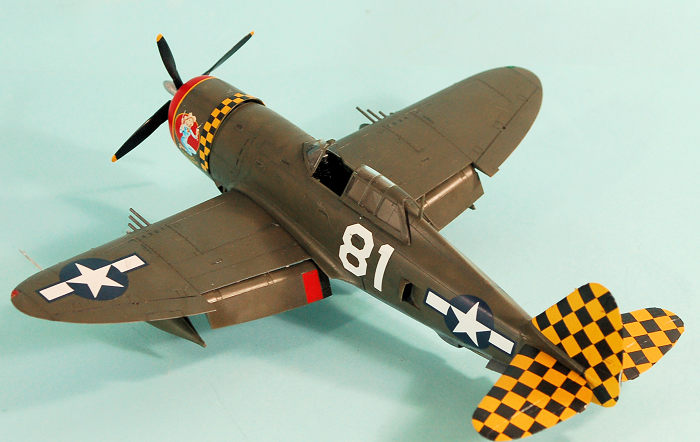 Tamiya’s
P-47s are commonly considered the best kits available of this famous fighter
in 1/48 scale. The kits are veryh well-designed, and any modeler who commits
to the radical act of following the instructions can be certain of producing
a beautiful model. Of the two, I like the “razorback” better, so when I ran
across a kit sitting on the shelves of the local hobby shop’s “estate sale”
section, marked to sell at $25.00 (half price!), there was no way I could
say no to having yet another P-47 in the stash.
Tamiya’s
P-47s are commonly considered the best kits available of this famous fighter
in 1/48 scale. The kits are veryh well-designed, and any modeler who commits
to the radical act of following the instructions can be certain of producing
a beautiful model. Of the two, I like the “razorback” better, so when I ran
across a kit sitting on the shelves of the local hobby shop’s “estate sale”
section, marked to sell at $25.00 (half price!), there was no way I could
say no to having yet another P-47 in the stash.
There are tons of decals modelers have in their stashes for Thunderbolts. When I went down to the third sub-basement of the decal dungeon, I rediscovered Cutting Edge’s “Thunderbolt Nose Art Part 2" which had as an option Don Kearns’ “Dallas Blonde.” That decided it and the kit went to the top of the to-do pile since I knew it was an easy way to get back in the groove after several months spent writing books and additional drafts of a screenplay.
| CONSTRUCTION |
The “razorback” kit doesn’t have the 165-gallon tanks, but fortunately the “bubbletop” version does, and I had kept the unused options from the “bubbletop” I built earlier this year.
 I
decided on an “out of the box” build other than the decals. I started by
pre-painting as much as possible: the cockpit, the engine, the cowling
interiors, etc. While all that was drying, I assembled the wings and painted
the wheel wells.
I
decided on an “out of the box” build other than the decals. I started by
pre-painting as much as possible: the cockpit, the engine, the cowling
interiors, etc. While all that was drying, I assembled the wings and painted
the wheel wells.
After picking out detail in the cockpit with a silver pencil, I assembled it, using the kit’s seat belt decal on a piece of old wine bottle lead foil, which allowed it to have “heft” when I attached it to the seat. Once the cockpit was installed, I assembled the fuselage, then went to assemble the engine and install it in the cowling and attach that sub-assembly to the fuselage.
I then attached the wings, and assembled the flaps for installation in the “down” position. With the horizontal stabilizers attached, it was time to go to the paint shop.
| COLORS & MARKINGS |
I painted the model with Tamiya “Neutral Grey” and “RAF Dark Green,”
which is a close match to early “green base” OD-41 Olive Drab, since both
colors were based on the old World War I color “P.C.10" mixture. Photos of
Kearns’ airplane showed the drop tanks he was carrying that day were dark,
so they w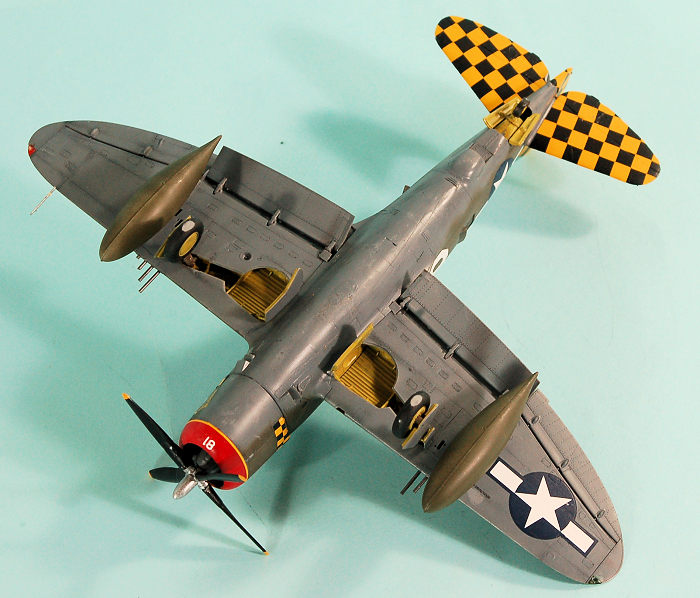 ere
painted with the RAF Dark Green also, as shown in the profiles of the Osprey
book “P-47 Thunderbolt Aces of the Ninth and Fifteenth Air Forces.” The
flaps were painted overall RAF Dark Green on the upper surface. P-47s that
came out of the factory in camouflage had their flaps painted before they
were attached to the airframe. A good way to know a P-47 started out NMF
before being painted in the field is that the leading edge of the flap,
which is inside the wing when raised, will show up silver, while those
painted at the factory are overall the upper color.
ere
painted with the RAF Dark Green also, as shown in the profiles of the Osprey
book “P-47 Thunderbolt Aces of the Ninth and Fifteenth Air Forces.” The
flaps were painted overall RAF Dark Green on the upper surface. P-47s that
came out of the factory in camouflage had their flaps painted before they
were attached to the airframe. A good way to know a P-47 started out NMF
before being painted in the field is that the leading edge of the flap,
which is inside the wing when raised, will show up silver, while those
painted at the factory are overall the upper color.
The decals included the checkerboards, done as a complete decal with black and yellow checks. The decals are a bit thick, and it took several applications of Solvaset over several hours to get them to settle down on the tail surfaces completely. The rest of the decals also needed several applications of Solvaset, but in the end everything came together looking right.
I gave the model an overall coat of Clear Flat varnish, then attached the landing gear and prop, unmasked the canopy an posed it open.
| CONCLUSIONS |
Tamiya’s P47s are “comfort food.” They’re easy enough to assemble that any modeler from beginner to expert can get a nice result. With a plethora of aftermarket decals produced over the years for Thunderbolts, there are endless marking possibilities. I’ve always been a fan of the Checkertail Clan, and this Thunderbolt looks good sitting next to my P-40F and P-51D with their distinctive tails.
7 June 2018
Copyright ModelingMadness.com
Review kit courtesy of the modeler who departed before he could get around to it; he always meant to and I’m sure he likes my result.
If you would like your product reviewed fairly and fairly quickly, please contact the editor or see other details in the Note to Contributors.
Back to the Main Page Back to the Review Index Page Back to the Previews Index Page